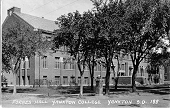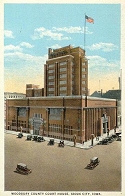|
|
|
Purcell and Elmslie, Architects Firm active :: 1907-1921
Minneapolis, Minnesota :: Chicago,
Illinois |
Ye Older Grindstones
7/17/2003
Forbes Hall of Science
Yankton College
George Grant Elmslie, architect
Yankton, South Dakota 1929Woodbury County Court House
William L. Steele, architect
Purcell and Elmslie, associated architects
Sioux City, Iowa 1915/1916Miscellanea. Clearing more of my desktop before hitting production meetings full-time, starting on Monday. Received from one regular reader of the Grindstone a nice postcard of Forbes Hall by Elmslie in the 1920s at Yankton College, one of a number of buildings he designed for what was a Christian education facility and which is now serving as a federal penal institution. Several of these buildings have been placed on the National Register. This images derives from a wonderful penny postcard resource maintained at RootsWeb, where a few other vintage views of buildings by Progressive architects can also be found. The listings are by state, then county, with handy thumbnails. Also updated the site statistics, which shows an upswing in interest as this site has developed.
Design for a stencil
Douglas Donaldson
circa 1920s
"Cordes
Oil on masonite
André Nejavitz, circa 1940s
Frame design by Douglas DonaldsonHooray for Hollywood. Just as I got on a roll with the below-mentioned Prairie School project, much prayed-for employment comes--or at least a short stint thereof. I've been hired as production designer for a feature film already in pre-production and which shoots on location in August. I'll be working 6 days a week on the sets, daybreak to sunset, until Labor Day weekend. Nice to insure that the DSL will continue to operate for a little while, even without anything new added by me.
Interestingly enough, Purcell himself took a foray into Hollywood during the 1920s. What a time to come! Before the Hays office was self-inflicted by the studios, the movies (and the reputation of Hollywood for them!) were near-orgiastic in places and certainly very much in the "anything goes" image of that decade. He came to town a couple of times in 1925 to hook up with his longtime friend Douglas Donaldson, a former Handicraft Guild member who hailed from Minneapolis during the P&E period and was in the process of setting himself up locally as a "color man." WGP had to content himself with a fruitless architectural consultation, but Donaldson eventually went on to a great career in the motion picture industry doing art direction for many MGM musicals in the 1940s and 1950s. He would haul 16 mm prints up to Westwinds for weekend screenings with Purcell, wife Cecily, and sister-in-law Dorothy O'Brien.
I have one artifact resulting from this lasting friendship, a painting presented to me by Dorothy O'Brien in 1981. Purcell helped a Hungarian architect named André Nejavitz, who had spent time in German concentration camps during WW II, get back on his feet in Paris after the war. The grateful Nejavitz sent Purcell a disconcertingly bright and happy abstract impressionist view of the village of Cordes in the south of France. WGP turned to his old friend Donaldson to frame the wooden panel, and Donaldson's name is stamped on the back of the resulting three-tone concoction (perhaps that is too critical a word). Anyway, the painting lived most of its life in Pasadena, some 20 miles from here, before being sent back with me to Minneapolis. To leave is to return to Southern California, I guess--at least in my case by way of Taliesin West.
Lastly, the curious connections of the Progressive era brought me into the world of Anne Baxter. The Academy Award-winning Baxter (Best Supporting Actress for The Razor's Edge, 1946) was the granddaughter of Frank Lloyd Wright and once a not too infrequent visitor to Taliesin West. She also happened to be one of my favorite actresses when I was a younger person, and it has been interesting to see how much of her presence still remains vibrant in the form of friends and family. So, for six weeks, I'll be experiencing a slice of her professional world and perhaps come closer to a decision about whether or not I have the background--or can gain it--necessary to write her biography. The research materials are have been piling up already for over two years.








